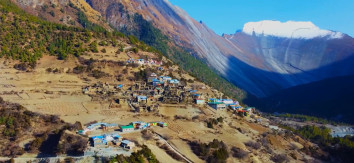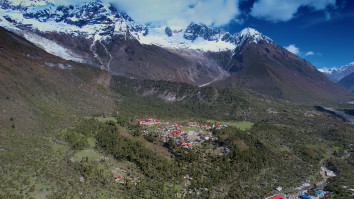
Kathmandu Durbar Square, a mesmerizing blend of history, culture, and spirituality, stands as a testament to Nepal's rich heritage. This historic plaza, located in the heart of Kathmandu, is a UNESCO World Heritage Site that attracts visitors from around the globe. From the residence of the Living Goddess to ancient temples and palaces, the square is a vibrant showcase of Newari architecture and tradition.
Kathmandu Durbar Square, known as Hanuman Dhoka Durbar Square, has been the epicenter of Nepalese royalty and culture for centuries. It served as the royal palace for the Malla Kings who ruled over the Kathmandu Valley until the 19th century. The square has witnessed the rise and fall of dynasties, each leaving an indelible mark on its architecture and culture.
In 1979, Kathmandu Durbar Square was designated a UNESCO World Heritage Site. This recognition underscores its historical and cultural significance. The square is a living museum, preserving centuries-old traditions, festivals, and architectural marvels that reflect the artistic and cultural zenith of the Kathmandu Valley.
Kathmandu Durbar Square is centrally located in Kathmandu, the capital city of Nepal. It is easily accessible by road, with numerous public transportation options available. The square is a bustling hub, surrounded by markets, shops, and eateries that offer a glimpse into the daily lives of the locals.
The square is a cultural heartland, where traditional festivals, religious ceremonies, and social gatherings take place. It is a living testament to the enduring customs of the Newar people, the indigenous inhabitants of the Kathmandu Valley. The intricate woodwork, stone carvings, and metal sculptures found here are a testament to their artistic prowess.
The Kumari Ghar, or House of the Living Goddess, is one of the most revered structures in Kathmandu Durbar Square. This ornate building is the residence of the Kumari, a young girl chosen through a rigorous selection process to be the living embodiment of the goddess Taleju. The Kumari is worshipped by both Hindus and Buddhists, and her appearance during festivals is considered a blessing.
Hanuman Dhoka, named after the Hindu monkey god Hanuman, served as the royal palace for centuries. The palace complex houses several courtyards, temples, and museums. The main entrance is guarded by a statue of Hanuman, and the complex is an architectural marvel that showcases the grandeur of the Malla kings.
The museum within the Hanuman Dhoka Palace complex offers a deep dive into the history of Nepalese royalty. It houses artifacts, thrones, portraits, and weapons used by the kings and queens. The museum provides an insightful glimpse into the opulent lifestyle and governance of the Malla and Shah dynasties.
Kathmandu Durbar Square has been the seat of power for the Malla kings, who were known for their patronage of art and culture. The square reflects their legacy through its temples, palaces, and courtyards. The Shah dynasty, which unified Nepal, also left its mark, further enriching the square’s historical tapestry.
The Taleju Bhawani Temple, dedicated to the goddess Taleju, is one of the most important temples in Kathmandu Durbar Square. Built in the 16th century by King Mahendra Malla, this temple is an architectural masterpiece. It is open to the public only once a year during the Dashain festival.
Nau-Talle Durbar, or the Nine-Story Palace, is a striking structure within the Hanuman Dhoka complex. This palace offers panoramic views of the square and the city beyond. Each floor is intricately designed, showcasing the architectural ingenuity of the Newar craftsmen.
The Swët Bhairab, a massive mask of the ferocious deity Bhairab, is unveiled only during the Indra Jatra festival. This fearsome representation of Lord Bhairab is a sight to behold, symbolizing protection and power. The mask is stored within the Hanuman Dhoka complex and is a significant cultural artifact.
The Shree Kaal Bhairav Temple is another important shrine in Kathmandu Durbar Square. Dedicated to the terrifying form of Lord Shiva, Kaal Bhairav, this temple is a place of worship and meditation. The statue of Kaal Bhairav, with its menacing expression, is believed to have the power to judge and punish.
The courtyards, or chowks, within Kathmandu Durbar Square are integral to its architectural layout. Each chowk has its own unique features and significance. The Nasal Chowk, Mul Chowk, and Sundari Chowk are among the most notable, featuring exquisite carvings, statues, and fountains.
The square comes alive during numerous festivals celebrated throughout the year. Dashain, Tihar, and Indra Jatra are among the most prominent. These festivals involve elaborate rituals, traditional music and dance, and processions that attract large crowds, both local and international.
Indra Jatra is one of the most spectacular festivals held at Kathmandu Durbar Square. Celebrated in honor of Lord Indra, the god of rain, this festival features masked dances, chariot processions, and the display of the Swët Bhairab mask. The Living Goddess Kumari is also paraded through the streets, blessing the onlookers.
Indra Jatra, named after the Hindu deity Indra, the god of rain and the king of heaven, is an eight-day festival held in late August or early September. The festival involves a series of events, including the Kumari Jatra (a chariot procession of the living goddess Kumari), masked dances, religious ceremonies, and various cultural displays.
Kumari Jatra: The chariot procession of the living goddess Kumari is one of the highlights of Indra Jatra. During this procession, people offer prayers and traditional drinks to the goddess and other deities.
Masked Dances: Various traditional dances, like the Lakhe (demon) dance and the Mahakali dance, are performed. Dancers and musicians often drink rakshi to maintain their energy levels and adherence to traditional practices.
Pole Erection Ceremony (Yosin or Linga): A ceremonial wooden pole, symbolizing Lord Indra's victory, is erected. Offerings, including rakshi, are made to this pole.
Indra's Capture: Depicting the mythological story where Indra is captured by the people of Kathmandu, symbolic enactments are performed. Rakshi is used during these rituals as part of the offerings and celebrations.
The tradition of the Kumari, the Living Goddess, is a unique aspect of Nepalese culture. The Kumari is chosen from the Shakya clan of the Newar community and is revered as the living incarnation of the goddess Taleju. She resides in the Kumari Ghar and makes public appearances during major festivals.
Kasthamandap, from which Kathmandu derives its name, is a historic wooden pavilion located near the square. Built in the 12th century, this structure is made entirely of timber and is a prime example of Newar craftsmanship. It served as a community shelter and a place for social gatherings.
The Maju Dega Temple, dedicated to the goddess Shiva-Parvati, is one of the tallest temples in Kathmandu Durbar Square. Its towering structure and tiered roofs are iconic features. The temple steps offer a popular vantage point for observing the bustling activities of the square.
Kathmandu Durbar Square is a treasure trove of Nepal's history, culture, and spirituality. From its grand temples and palaces to its vibrant festivals and the revered Living Goddess, the square offers an unparalleled glimpse into the heart of Nepalese heritage. Visiting this UNESCO World Heritage Site is a journey through time, revealing the enduring legacy of the Malla and Shah dynasties and the artistic brilliance of the Newar craftsmen.
 Discover Pisang Village, a scenic stop on the Annapurna Circuit Trek. Experience stunning Himalayan views, local culture, and peaceful mountain charm in Nepal's Manang District.
Discover Pisang Village, a scenic stop on the Annapurna Circuit Trek. Experience stunning Himalayan views, local culture, and peaceful mountain charm in Nepal's Manang District.
 Discover Chame Village, a scenic gateway to the Annapurna Circuit and Himalayan treks like Tilicho Lake and Nar Phu Valley. Learn about its culture, location, attractions, and trekking routes.
Discover Chame Village, a scenic gateway to the Annapurna Circuit and Himalayan treks like Tilicho Lake and Nar Phu Valley. Learn about its culture, location, attractions, and trekking routes.
 Explore Besisahar, the gateway to the Annapurna Circuit in Nepal. Discover scenic landscapes, local culture, trekking routes, and travel tips for your Himalayan adventure.
Explore Besisahar, the gateway to the Annapurna Circuit in Nepal. Discover scenic landscapes, local culture, trekking routes, and travel tips for your Himalayan adventure.
 Lobuche Village Nepal: know the weather, location, tea houses, restaurants, altitude, near by location of Lobuche, all info you need to know about
Lobuche Village Nepal: know the weather, location, tea houses, restaurants, altitude, near by location of Lobuche, all info you need to know about
 Discover Tilije Village, a serene stop on the Manaslu Circuit Trek in Nepal. Surrounded by mountains and Tibetan culture, it's the perfect place to rest, explore, and experience authentic Himalayan hospitality.
Discover Tilije Village, a serene stop on the Manaslu Circuit Trek in Nepal. Surrounded by mountains and Tibetan culture, it's the perfect place to rest, explore, and experience authentic Himalayan hospitality.
 Discover Bhimtang Village, a scenic stop on the Manaslu Circuit Trek. Surrounded by glaciers and alpine beauty, it offers cozy lodges, mountain views, and cultural charm at 3,720 meters.
Discover Bhimtang Village, a scenic stop on the Manaslu Circuit Trek. Surrounded by glaciers and alpine beauty, it offers cozy lodges, mountain views, and cultural charm at 3,720 meters.
 Discover Dharamshala in Nepal, a peaceful rest and acclimatization stop on the Manaslu Circuit Trek. Enjoy stunning mountain views, cozy lodges, and prepare for the challenging Larkya La Pass ahead.
Discover Dharamshala in Nepal, a peaceful rest and acclimatization stop on the Manaslu Circuit Trek. Enjoy stunning mountain views, cozy lodges, and prepare for the challenging Larkya La Pass ahead.
 Discover Samdo Village, a remote Himalayan settlement near the Tibetan border. Explore its unique Tibetan culture, scenic landscapes, and its role as the last stop before crossing Larkya La Pass on the Manaslu Circuit Trek.
Discover Samdo Village, a remote Himalayan settlement near the Tibetan border. Explore its unique Tibetan culture, scenic landscapes, and its role as the last stop before crossing Larkya La Pass on the Manaslu Circuit Trek.
 Discover Samagaun Village in Nepal, a scenic stop on the Manaslu Circuit Trek known for its Tibetan culture, mountain views, and peaceful Himalayan charm.
Discover Samagaun Village in Nepal, a scenic stop on the Manaslu Circuit Trek known for its Tibetan culture, mountain views, and peaceful Himalayan charm.
 Explore Shyala Village on the Manaslu Trek and enjoy stunning views and rich culture. Plan your Himalayan adventure now!
Explore Shyala Village on the Manaslu Trek and enjoy stunning views and rich culture. Plan your Himalayan adventure now!
All contents Within this website is copyright Protected © 2025 | Adventure Vision Treks and Travels Pvt. Ltd.